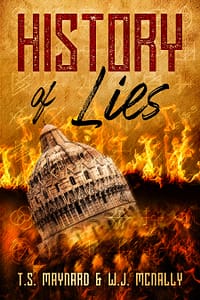"...a captivating and thought-provoking conspiracy thriller that will challenge everything you thought you knew about history. This epic novel is replete with suspenseful twists and turns that will keep you on the edge of your seat, eagerly anticipating what will happen next." —Literary Titan
The Story Behind the Story
Why did we write it?
The original idea for History of Lies came about when we read an article that described a technology with the potential to restore sight to the blind. The device converted brain waves into images. From there, we imagined what would happen if you applied such a contraption to someone who was dying. They say your life flashes before your eyes, so what would happen if we found a bunch of lives flashing before someone’s eyes? It would be a discovery that would change the world.
But that’s not what HOL is about. What happened?
We’ve written A LOT of versions of HOL. If you think about past lives, it’s the type of idea that can splinter off in so many interesting ways (and it felt like we attempted all of them). Some of our other attempts were decent, but every time the story lost steam about 2/3rds in. We loved the notion of past lives, and we felt we had something really cool, but we struggled to crack it. We almost gave up on it, but eventually we explored the idea of people with past lives who have been manipulating the world for thousands of years. When the technology comes along that could expose them, they must eliminate it along with anyone who knows their secret.
What was our biggest takeaway from writing this book?
Persistence is essential in writing. This book has been our most difficult to write, by far. In some ways, we’re rewriting the history of the world, which is an impossible task, so we needed to rewrite elements of it while still remaining credible.
We also learned that story structure can help break writer’s block. This story didn’t fully take shape until we settled on a somewhat unique structure. As you read the book, you’ll notice there are multiple storylines. With each chapter, we focus on one story and we ping-pong back and forth between the past and present. The cadence is 1, 2, 3, 1, 2, 3 UNTIL one of the past storylines finishes and we go to a different time period. Then it switches to 1, 3, 4, 1, 3, 4. You could re-read the book and focus on say story 2 and you’d have a complete story with a beginning, middle, and end.
The other unique element of the structure is we designed it so that as a reader the past storylines inform the present (which makes logical sense), BUT the present story also informs the past (which isn’t as intuitive). We felt that made a big difference in building the tension and keeping all the stories engaging.
Who do we think will enjoy History of Lies the most?
Readers who like big, epic conspiracies. This one spans thousands of years, so it’s hard to go bigger than that. It has similarities in scope to a book like The DaVinci Code where you’re unraveling a mystery centuries in the making. Fans of history will hopefully enjoy how we’ve taken true events and layered in our fictional premise. As two smaller examples within the book, the bar depicted in the pirate vignette was an actual place, and the Vestal Virgins sequence is inspired by an actual tradition. We spent a lot of time trying to add actual historical details.
One interesting point with respect to history, there are some folks who watch movies based on past events and they criticize the historical accuracy of them. We’ve come to the conclusion that, in many instances, no one knows with certainty whether it is wrong. The critics are basing their opinions on what they’ve read or been taught. But what if those sources are wrong? We can’t agree on events that happened yesterday. How can we possibly have certainty about events that occurred hundreds of years ago?
No one can truly know what happened in the past, which is part of what we find fascinating in a story like this.
